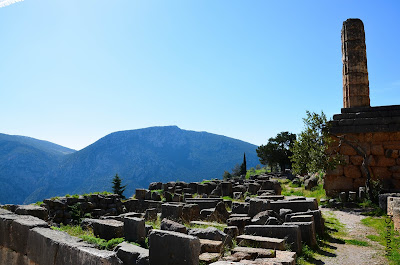Delphi is
famous as the ancient sanctuary that grew rich as the seat of the oracle that
was consulted on important decisions throughout the ancient classical world.
Moreover, it was considered as the navel (or centre) of the world by the Greeks
as represented by the Omphalos.
It occupies
an impressive site on the south-western slope of Mount Parnassus overlooking
the coastal plain to the south and the valley of Phocis. It is now an extensive
archaeological site and the modern town is nearby.
It is
recognised by UNESCO as a World Heritage Site in having had a phenomenal
influence in the Ancient world, as evidenced by the rich monuments built there
by most of the important ancient Greek city-states, demonstrating their
fundamental Hellenic unity.
The site of
Delphi is located in upper central Greece, on multiple plateaux/terraces along
the slope of Mount Parnassus, and includes the Sanctuary of Apollo, the site of
the ancient Oracle. This semicircular spur is known as Phaedriades, and
overlooks the Pleistos Valley.
Southwest
of Delphi, about 15 km (9.3 mi) away, is the harbor-city of Kirrha on the
Corinthian Gulf. Delphi was thought of by the Greeks as the middle of the
entire earth.
Apollo is
connected with the site by his epithet Delphinios, "the Delphinian".
The epithet is connected with dolphins in the Homeric Hymn to Apollo, recounting
the legend of how Apollo first came to Delphi in the shape of a dolphin,
carrying Cretan priests on his back. The Homeric name of the oracle is Pytho.
Another legend held that Apollo walked to Delphi from the north and stopped at
Tempe, a city in Thessaly, to pick laurel (also known as bay tree) which he
considered to be a sacred plant. In commemoration of this legend, the winners
at the Pythian Games received a wreath of laurel picked in the Temple.
Delphi
became the site of a major temple to Phoebus Apollo, as well as the Pythian
Games and the famous prehistoric oracle. Even in Roman times, hundreds of
votive statues remained, described by Pliny the Younger and seen by Pausanias.
However,
ancient as well as modern scholars have doubted the legitimacy of such
inscriptions. According to one pair of scholars, "The actual authorship of
the three maxims set up on the Delphian temple may be left uncertain. Most
likely they were popular proverbs, which tended later to be attributed to
particular sages."
The Pythian
Games took place every four years to commemorate Apollo's victory. Another
regular Delphi festival was the "Theophania", an annual festival in
spring celebrating the return of Apollo from his winter quarters in Hyperborea.
The culmination of the festival was a display of an image of the gods, usually
hidden in the sanctuary, to worshippers.
The
"Theoxenia" was held each summer, centred on a feast for "gods
and ambassadors from other states". Myths indicate that Apollo killed the
chthonic serpent Python, Pythia in older myths, but according to some later
accounts his wife, Pythia, who lived beside the Castalian Spring. Some sources
say it is because Python had attempted to rape Leto while she was pregnant with
Apollo and Artemis.
Photography Myrofora Ch.
























No comments:
Post a Comment